The World Press Trends Outlook 2024-2025, the 30th edition of an annual report by WAN-IFRA (World Association of News Publishers), offers a comprehensive look at the opportunities and challenges facing news publishers worldwide.
Based on a survey of over 240 senior media executives from 85 countries around the world, the report identifies key trends that will shape the industry's future and provides valuable insights to guide strategic decision-making.
The findings highlight a mix of optimism and caution as news publishers navigate an evolving media landscape characterized by declining print revenues, digital growth, and the rising impact of artificial intelligence.
Here are five key insights from the report that can help media professionals understand the changing dynamics of the industry.
1. The gradual decline of print
For the first time, print revenue has dropped below the 50% mark, accounting for just under 45% of total publisher income. This is down from 57.5% in 2023. While this decline signals a continued shift toward digital, print remains an important source of revenue, especially in markets such as Japan and India, where print readership remains significant.
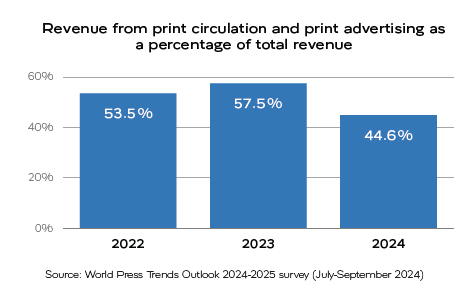
Despite the drop in revenue from print, many publishers are adopting a hybrid approach, balancing print and digital to serve diverse audience — and advertiser — preferences.
Some media outlets are using print as a premium product while aggressively expanding their digital footprint through paywalls and membership models. However, the financial challenge of juggling print, while growing digital, remains, especially at a time of rising print production costs and continued shifts in consumer habits.
2. Digital revenue growth — steady but insufficient
Digital revenue now makes up 31% of total revenue, marking a 7% year-on-year increase. Subscriptions, paywalls, and monetization of digital content — such as podcasts and newsletters — are driving this growth. Yet, despite these positive trends, digital growth alone is not sufficient to offset the steep declines in print revenue.
The report suggests that publishers must refine their digital strategies, focusing on personalized content, dynamic paywall models, and audience segmentation to optimize their digital efforts, and to effectively monetize them.
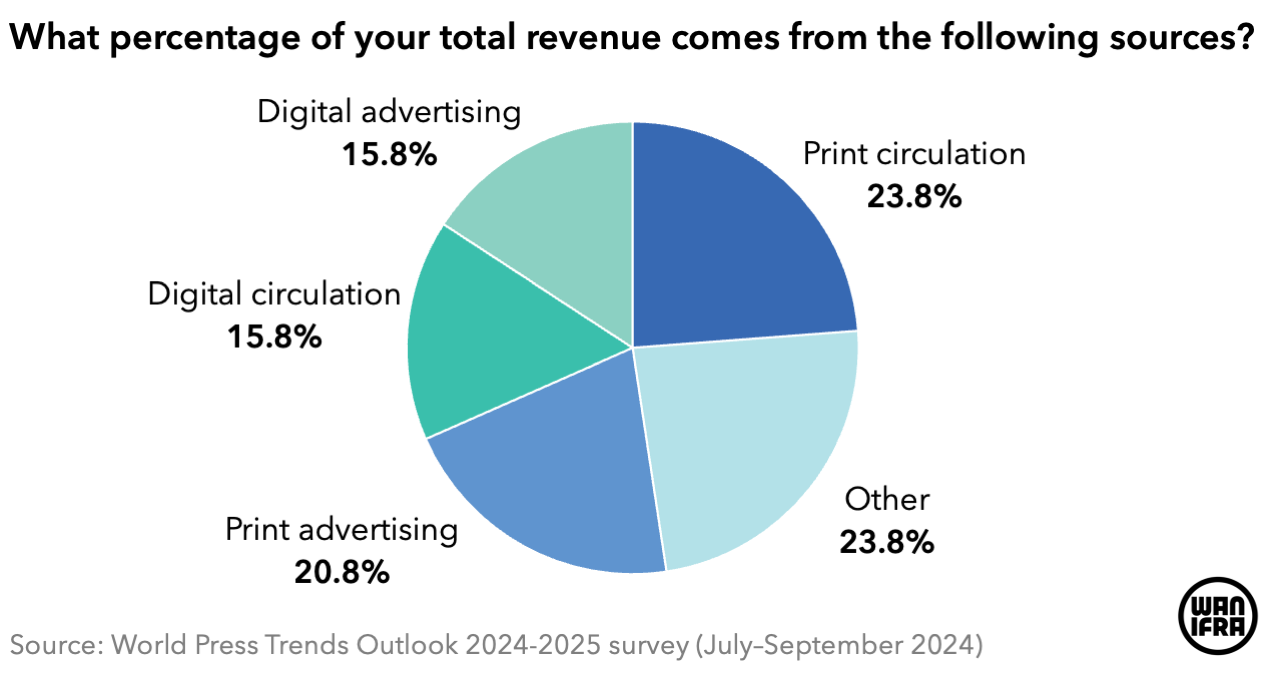
3. Diversifying revenue streams is essential
Revenue diversification has long been a strategic imperative. The report makes that clearer than ever, given the findings about declining income from print and the speed of any digital uptick.
The good news is that across WAN-IFRA’s sample, 23.8% of total revenue comes from alternative sources such as events, e-commerce, and memberships.
These income streams are proving to be critical for long-term sustainability, offering publishers new ways to engage their audiences and generate revenue beyond traditional advertising and subscriptions.
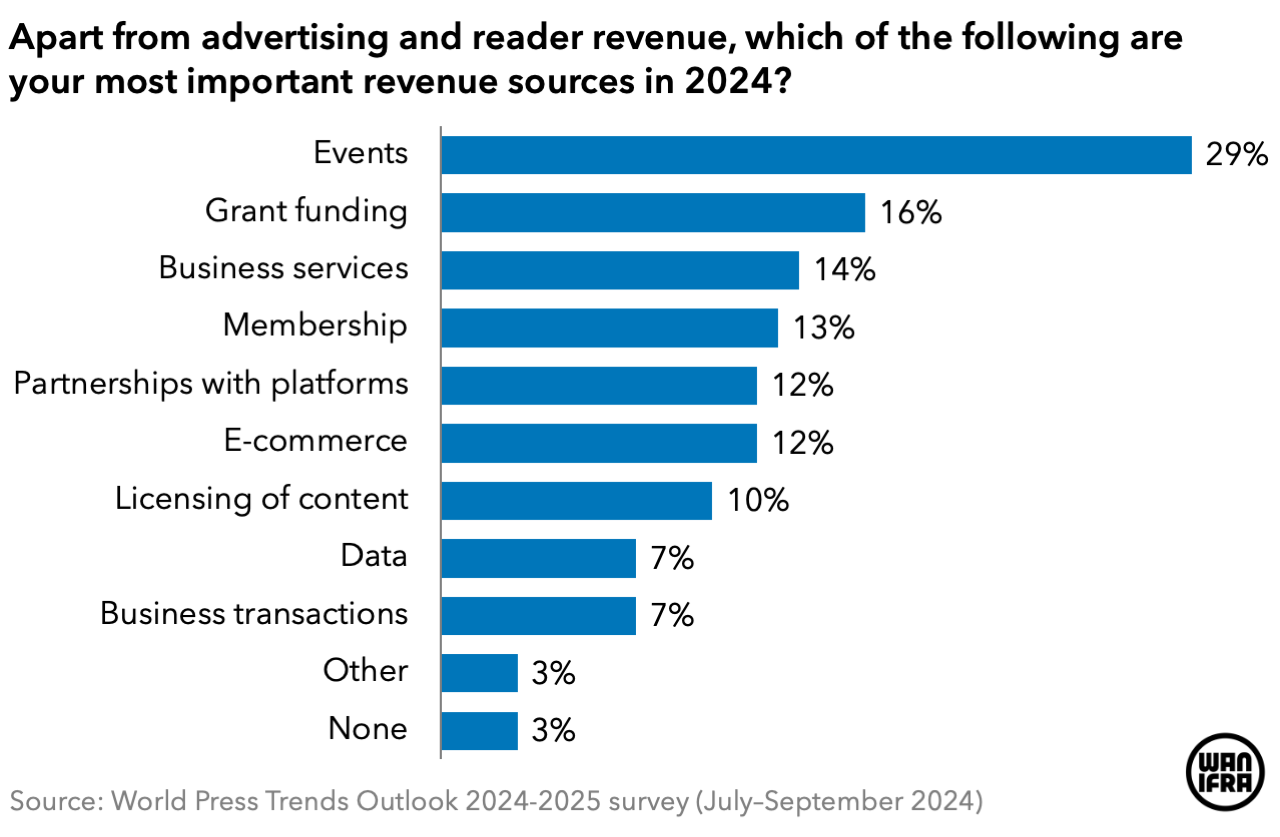
Events, in particular, are emerging as a leading revenue stream, with some publishers reporting that they now contribute up to 40% of their overall revenue. Successful case studies featured in the full report highlight how media organizations leverage their brand authority to host industry conferences, community events, and sponsored workshops.
Membership models are also gaining traction, with outlets such as The Guardian and The Daily Maverick successfully driving reader engagement and loyalty through voluntary contributions and exclusive content offerings for members.
4. AI is changing the game, but challenges persist
Artificial intelligence is increasingly transforming newsroom operations. From automating workflows to enabling personalized content recommendations and audience insights, AI is proving to be a valuable tool for publishers. However, highlighting earlier WAN-IFRA data, the report reiterates that only 13% of media leaders believe their organizations are well-prepared to fully integrate AI into their operations.
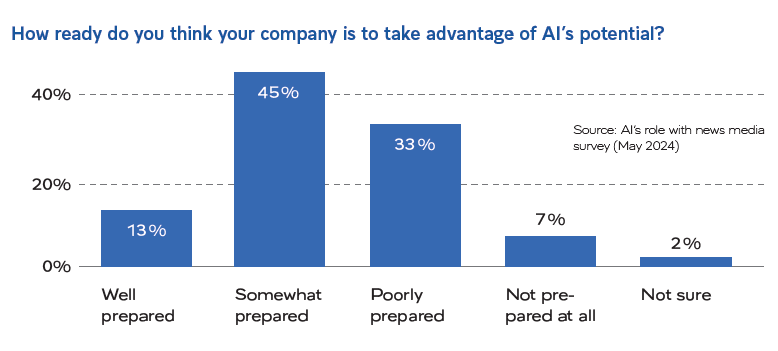
Key challenges include copyright concerns, ethical considerations, and the need for newsroom-wide adoption. AI-driven tools such as dynamic paywalls and chatbots are helping to optimize reader experiences, but publishers are urged to ensure that their AI strategies align with editorial values and do not compromise journalistic integrity.
Additionally, AI adoption varies by region, with developing markets facing greater hurdles due to limited technical infrastructure and expertise. Investment in AI training and partnerships with technology providers will be critical for closing this gap.
5. Press freedom faces mounting threats
One of the most alarming findings in the report is the increasing threat to press freedom globally. In 2024, nearly 100 journalists were killed, with WAN-IFRA’s new research highlighting a sharp rise in online harassment, legal threats, and cyberattacks. The situation is particularly dire in developing markets, where journalists often operate under restrictive legal environments and face significant online and in-person safety risks.
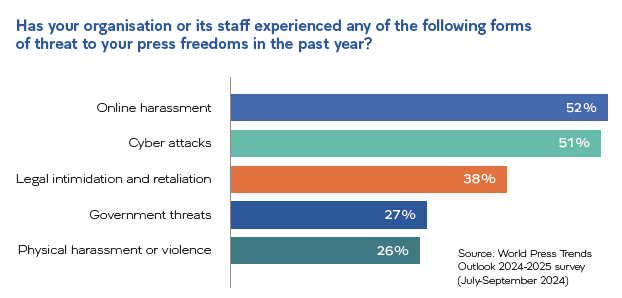
The report stresses the need for media organizations to invest in digital safety training, cybersecurity measures, and advocacy efforts to protect journalists and maintain editorial independence. Regulatory actions and platform policies are also impacting media freedom, with some publishers expressing concerns over algorithmic bias and content moderation decisions (or lack thereof) made by major tech platforms.
Despite these challenges, the report emphasizes the importance of collaborative efforts between media organizations, advocacy groups, and policymakers to safeguard press freedom and ensure a sustainable future for independent journalism. One such initiative, the European Anti-SLAPP Conference, brought together 30 speakers and over 250 participants from 25 countries, with the goal of countering SLAPPs and protecting individuals engaged in public participation from unfounded claims and abusive legal proceedings. These types of fora will only become more important.
Looking ahead: The road to sustainability
Despite the challenges outlined in the report, optimism among publishers is on the rise.
Fully 61% of respondents expressed confidence about their business prospects for the next 12 months, a figure that rises to 64% when looking three years ahead. This optimism is driven by ongoing digital transformation, revenue diversification efforts, and strategic investments in technology.
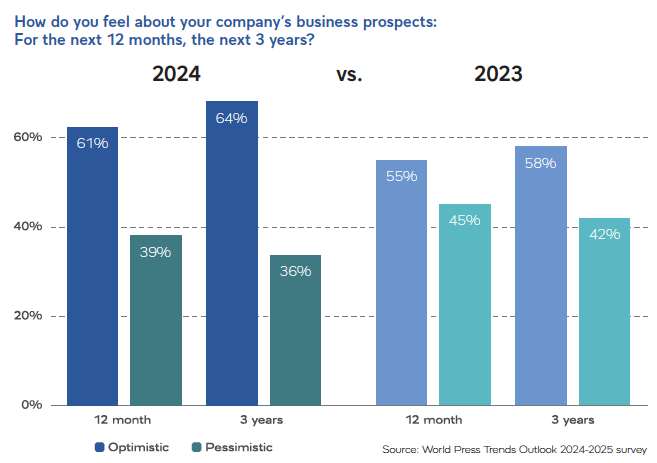
However, optimism alone isn’t enough. Sustained success will depend on how effectively publishers can adapt to shifting revenue models, technological advancements, and evolving audience behaviors.
Based on the report’s findings, four key priorities stand out for media organizations moving forward:
(1) Invest in innovation and experiment relentlessly. Whether testing new content formats, platform strategies, or revenue models, innovation must be constant to meet evolving audience needs and drive your business forward.
(2) Double down on community engagement by building strong relationships with audiences through memberships and events that can drive loyalty and revenue. Audiences are more than just your subscribers. They are also stakeholders. Make them feel invested in your future.
(3) Get smarter with data and AI. The industry is awash with data, but using it effectively — whether for content personalization, dynamic paywalls, serving more relevant advertising, or supporting product development — will define the next wave of digital success.
(4) Vociferously defend press freedom. Media organizations must champion press freedom by collectively advocating for stronger protections and legal frameworks in order to support independent journalism worldwide. This is essential for the industry’s long-term viability, and to ensure that communities and audiences get the information they need.
As these takeaways demonstrate, the annual World Press Trends Outlook study offers more than a snapshot of the industry — it provides a potential roadmap for what comes next, and how to successfully navigate it. By understanding, and embracing, change, publishers can ensure they remain relevant and resilient in the years to come.
To help them do this, the report is full of case studies from around the world which can offer inspiration and affirmation for the work you are doing. I encourage you all to dive in!
For more insights and to receive a copy of the full report (which is currently only available for WAN-IFRA members), please contact Dean Roper, Director of Insights and Editor-in-Chief, WAN-IFRA: dean.roper@wan-ifra.org.


